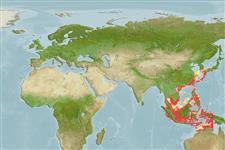Common names from other countries
Classification / Names / Names
俗名 | 同种异名 | Catalog of Fishes (gen., sp.) | ITIS | CoL | WoRMS
Environment: milieu / climate zone / depth range / distribution range
生态学
礁区鱼类; 半咸淡水; 深度上下限 0 - 65 m (Ref. 111223). , preferred 26°C (Ref. 107945); 35°N - 15°S, 99°E - 137°E
Indo-West Pacific: from China, Japan and Korea to Philippines and westwards to the straits of Malaccca, also present in the Northern Territory, Australia. Tropical to subtropical.
Length at first maturity / 大小 / 重量 / 年龄
Maturity: Lm 6.5, range 6 - ? cm Max length : 20.0 cm CW 雄鱼/尚未辨别雌雄; (Ref. 343)
Carapace rough to granulose, regions discernible; front with 4 acutely triangular teeth; 9 teeth on each anterolateral margin, the last tooth 2 to 4 times larger than preceding teeth. Chelae elongate in males; larger chela with conical tooth at base of fingers; pollex ridged. Color: males with blue markings, females dull green.
Matures at about 1 year. Collected mainly by artisanal traps, trawls, beach seines, cylindrical wire traps, folding traps, pots, hop nets, drop nets, and sunken crab gill nets. In shallow waters, it is caught using beach seines, rakes, and dab nets. Sold in local markets (fresh or frozen) and for the crab-flesh canning industry. Most widely sold in markets of Southeast Asia, including the Philippines (Ref. 343). Maximum depth from Ref. 801.
Life cycle and mating behavior
成熟度 | 繁殖 | 产卵场 | 卵 | 孕卵数 | 仔鱼
Members of the order Decapoda are mostly gonochoric. Mating behavior: Precopulatory courtship ritual is common (through olfactory and tactile cues); usually indirect sperm transfer.
主要参考文献
参考文献 | 合作者 | 合作者
Ng, P.K.L. 1998. (Ref. 343)
世界自然保护联盟红皮书 (Ref. 130435: Version 2024-1)
Not Evaluated
Not Evaluated
对人类的威胁
人类利用
渔业: 高经济性
FAO - 养殖: 产生; 渔业: landings, 物种外形 | FishSource | 周边海洋
工具
网络资源
Estimates based on models
Preferred temperature
(Ref.
115969): 18.1 - 29, mean 27.6 (based on 1324 cells).
回复力
高度, 族群倍增时间少于 15个月 (K=0.1-3.11).
Prior r = 1.19, 95% CL = 0.78 - 1.78, Based on 22 data-limited stock assessments.
脆弱性
Low vulnerability (10 of 100).
